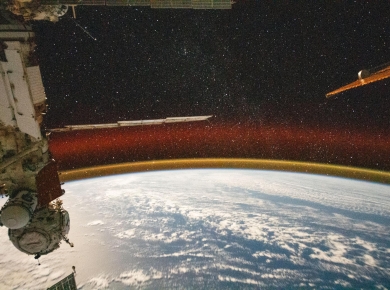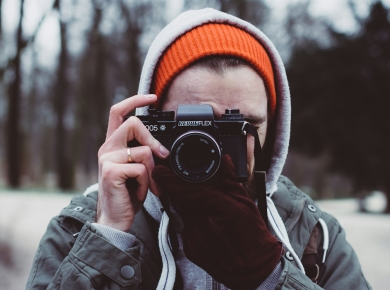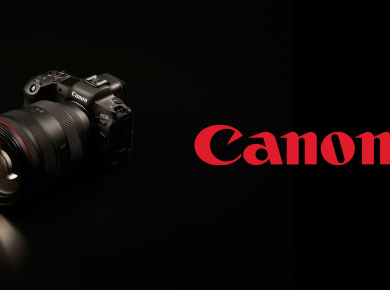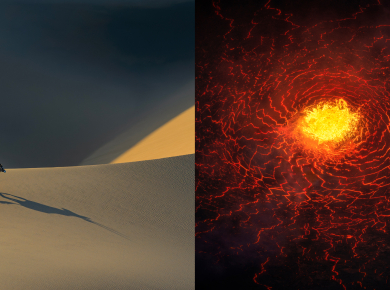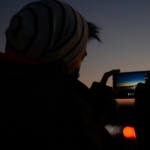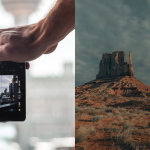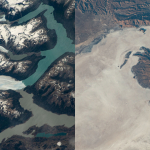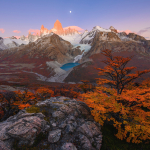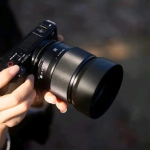Navigating the vast terrain of photography language can be bewildering for newcomers, and that’s why Lens Front has crafted a comprehensive glossary. Our glossary is a valuable resource not just for beginner photographers, but everyone.
Use the index below to jump to specific sections, and delve deeper into certain terms with linked guides, ensuring a thorough understanding of each topic.
A B C D E F G H I J K L M N O P Q R S T U V W X Y Z
A
Absolute Resolution: The maximum level of detail that a camera or imaging system can capture, often measured in pixels per inch (PPI) or dots per inch (DPI).
Active Area: The portion of an image sensor that is sensitive to light and captures the actual image. It excludes any non-sensitive border areas. The active area can vary depending on camera modes, however it often will be less than the absolute resolution.
Aliasing: A visual artifact in digital imaging characterized by jagged or stair-step patterns in areas with high-frequency details, such as fine lines or curves. Aliasing occurs when the resolution of the image or display is insufficient to accurately represent the high-frequency information, leading to distortions. Tools, such as anti-aliasing algorithms or filters, exist to mitigate aliasing by smoothing out these jagged edges, resulting in a more visually pleasing and accurate representation of the original content.
Ambient Light: The natural or existing light present in a scene, not originating from any artificial light sources or flashes.
Aperture: The aperture in a camera lens is the adjustable opening through which light enters the camera. Measured in f-stops, a lower f-number (e.g., f/1.8) indicates a wider open aperture, allowing more light to reach the camera sensor. A higher f-number (e.g., f/16) means a smaller aperture, restricting the amount of light. Besides regulating exposure, the aperture also influences the depth of field, controlling how much of the image is in sharp focus. A wider aperture (lower f-number) results in a shallower depth of field, isolating the subject from the background, while a narrower aperture (higher f-number) increases depth of field, keeping more of the scene in focus.
Aperture Priority: A camera shooting mode where the photographer sets the aperture, and the camera automatically adjusts the shutter speed for proper exposure.
Astrophotography: A specialized form of photography that involves capturing images of celestial objects, such as stars, planets, and galaxies.
Aspect Ratio: The proportional relationship between the width and height of an image. Common aspect ratios include 4:3, 3:2, and 16:9.
Auto White Balance: A camera feature that automatically adjusts the color balance of a photo based on the color temperature of the light source, ensuring accurate color reproduction.
Autofocus: Autofocus is a camera feature that automatically adjusts the lens to achieve sharp focus on the subject. Using sensors or contrast-detection algorithms, autofocus systems quickly analyse the scene and adjust the lens elements to bring the subject into clear focus. Modern cameras often employ various autofocus modes.
APS-C (Advanced Photo System – Classic): A sensor size standard in digital cameras, smaller than a full-frame sensor but larger than a micro four-thirds sensor.
B
Back Button Focus: A camera setup where the autofocus function is decoupled from the shutter button and assigned to a button on the back of the camera. This allows photographers to separate the act of focusing from the shutter release, providing more control over the focusing process.
Background: In photography, the area behind the main subject of an image. A well-managed background can enhance the composition by complementing or contrasting with the subject, contributing to a visually appealing and balanced photograph.
Backlighting: The illumination of a subject from the rear, creating highlights along its edges. Backlighting can add depth, drama, and a sense of separation from the background in a photograph.
Barrel Distortion: A lens aberration causing straight lines near the edges of the frame to appear curved outward, resembling the bulging shape of a barrel. Common in wide-angle lenses.
Blooming: A visual artifact in digital imaging where intense light sources cause surrounding areas to appear overly bright or washed out, often seen in high-contrast situations.
Blowout: The loss of detail in overexposed areas of a photograph, resulting in pure white highlights. Also referred to as highlight clipping.
Blue Hour: The period of twilight before sunrise and after sunset when the sky takes on a deep blue hue. It is favored by photographers for its unique lighting conditions.
Bokeh: The aesthetic quality of the out-of-focus areas in a photograph. Desirable bokeh is often characterized by smooth, creamy, and visually pleasing background blur.
Bulb Mode: A camera mode that allows the shutter to stay open as long as the shutter button is held down, enabling long-exposure shots, often used in low-light conditions or for creative effects.
Burst Mode: A camera setting that allows rapid consecutive shots to be taken with a single press of the shutter button, useful for capturing fast-moving subjects or creating a sequence of images.
Burst Rate: The number of frames a camera can capture per second in burst mode. It indicates the camera’s continuous shooting speed and is measured in frames per second (fps).
C
Camera Body: The main housing of a camera that contains the image sensor, processing components, and controls. The camera body, or chassis, is the foundation onto which lenses and other accessories are attached.
Camera Mode: The specific configuration or setting of a camera that determines how it captures an image. Common modes include manual, aperture priority, shutter priority, and program mode, each offering different levels of control over exposure settings.
Camera Shake: Unintentional movement of the camera during exposure, resulting in a blurry image. Camera shake can be minimised through proper stabilisation techniques, such as using a tripod or faster shutter speeds.
Candid Photography: Capturing spontaneous moments without the subject’s awareness. Candid photography aims to capture genuine emotions and expressions in unposed situations.
Chromatic Aberration: An optical phenomenon where colours are focused at different points, causing colour fringing, especially at high-contrast edges. Chromatic aberration is corrected using specialised lens coatings or software.
CMOS Sensor: A type of image sensor used in digital cameras. Complementary Metal-Oxide-Semiconductor (CMOS) sensors are known for their energy efficiency, faster readout speeds, and suitability for video recording.
Colour Palette: The range of colours used in an image. A well-managed colour palette contributes to the overall mood and visual impact of a photograph.
Composition: The arrangement of visual elements in a photograph. Composition principles include the rule of thirds, leading lines, framing, and balance, influencing how viewers perceive and interpret an image.
Compression: The reduction of file size in digital imaging through compression algorithms. Compression can be lossy or lossless, with lossy compression sacrificing some image data for smaller file sizes.
Contrast: The difference in brightness between the lightest and darkest parts of an image. High contrast emphasises differences, while low contrast results in a more even tonal range.
Crop Factor: The ratio of a camera’s image sensor size to that of a full-frame sensor. It affects the effective focal length of a lens and influences the field of view. A crop factor less than 1 indicates a smaller sensor, while greater than 1 indicates a larger sensor.
D
Depth of Field: The range of distances in a photograph where objects appear acceptably sharp. A shallow depth of field isolates subjects from the background, while a deep depth of field keeps more of the scene in focus.
Digital Zoom: A camera feature that simulates zooming by cropping and enlarging a portion of the image captured by the sensor. Unlike optical zoom, digital zoom can result in a loss of image quality.
Distortion: The alteration or deformation of an image, often in terms of shape or perspective. Distortion can be caused by lens aberrations, such as barrel distortion or pincushion distortion.
Dots per Inch (DPI): A measurement of image resolution, indicating the number of individual dots (pixels) within one inch. DPI is commonly used in printing and scanning to determine image sharpness and detail.
Digital Single-Lens Reflex (DSLR): A type of digital camera that uses a mirror mechanism to reflect light from the camera’s lens up into an optical viewfinder. DSLRs offer interchangeable lenses and manual controls for advanced photography.
Dynamic Range: The range of tones between the darkest and lightest parts of an image. A higher dynamic range allows a camera to capture more detail in both shadow and highlight areas, resulting in a more visually balanced photograph.
E
Electronic Viewfinder (EVF): A viewfinder that uses electronic displays, such as LCD or OLED screens, to provide a digital preview of the scene. EVFs are commonly found in mirrorless cameras and offer features like real-time exposure simulation and focus peaking.
EXIF Data: Exchangeable Image File Format data that accompanies digital images. EXIF data includes information such as camera settings (shutter speed, aperture, ISO), date and time, location, and other details about how the photograph was taken.
Exposure: The total amount of light reaching the camera sensor or film, determined by the combination of aperture, shutter speed, and ISO settings. Proper exposure results in a well-balanced and appropriately bright or dark image.
Exposure Triangle: The relationship between three key exposure settings: aperture, shutter speed, and ISO. Adjusting one of these settings affects the others, and finding the right balance is crucial for achieving proper exposure in a photograph.
F
F-stop: A measurement of the aperture size in a camera lens, representing the ratio of the lens’s focal length to the diameter of the entrance pupil. Lower f-stop values indicate larger apertures, allowing more light to enter the camera.
Filters: Transparent or translucent accessories placed in front of a camera lens to modify or enhance the image. Filters can be used for various purposes, such as reducing glare, enhancing colors, or creating specific effects like long exposure or polarizing.
Firmware: Software embedded in a camera’s hardware that controls its operation. Firmware updates can enhance camera functionality, fix bugs, or introduce new features.
Flat Light: Lighting conditions that lack strong shadows and highlights, resulting in even and subdued illumination. Flat light can be advantageous for reducing contrast and revealing details, especially in portraiture.
Focal Length: The distance from a camera lens to its image sensor, determining the lens’s magnification and field of view. Measured in millimeters, longer focal lengths provide more magnification and narrower fields of view.
Focus: The act of adjusting a camera’s lens to achieve sharpness and clarity in the image. Auto focus systems use sensors to detect the optimal focus point, while manual focus requires the photographer to adjust the lens directly.
Focus Stacking: A technique where multiple images taken at different focus distances are combined in post-processing to achieve a greater depth of field. This is commonly used in macro photography and landscapes.
Frames per Second (FPS): The number of individual frames a camera can capture in one second. Higher FPS is beneficial for capturing fast-moving subjects, and it is a crucial specification for action photography and videography.
Full-Frame: Refers to a camera with a sensor size equivalent to a 35mm film frame, providing a larger field of view compared to cropped sensors. Full-frame cameras are valued for their improved low-light performance and depth of field control.
G
Golden Hour: The period shortly after sunrise and before sunset when the sunlight is soft, warm, and diffused. The low angle of the sun during the golden hour creates long shadows and a golden tone, enhancing the overall aesthetics of photographs.
Grain: The visible, often speckled, texture in a photograph caused by film or digital noise. In film photography, it results from the size of the silver halide crystals, while in digital photography, it is caused by high ISO settings. Grain can be intentionally added for artistic effect or minimised through noise reduction techniques.
H
HDR (High Dynamic Range): A technique that combines multiple exposures of the same scene to capture a wider range of light and detail, especially in high-contrast situations.
Histogram: A graphical representation of the distribution of tones in an image, helping photographers assess exposure levels.
Hot Shoe: A mounting point on top of a camera, typically with electrical contacts, used for attaching external accessories such as a flash unit or an external microphone. The hot shoe allows these accessories to communicate with the camera and receive power if needed.
I
ICC Profile: A standardised set of data that characterises the colour properties of a device, such as a camera or a monitor. ICC profiles ensure consistent and accurate colour reproduction across different devices, essential for maintaining colour fidelity in digital imaging workflows.
Image Stabilisation: A technology designed to reduce the effects of camera shake during handheld photography. Image stabilisation systems can be optical (lens-based) or sensor-based, minimising blurriness caused by slight movements of the camera.
ISO: ISO refers to the sensitivity of the camera sensor to light. A lower ISO value (e.g., ISO 100) is used in bright conditions, while a higher ISO value (e.g., ISO 1600) is employed in low-light situations. Increasing ISO also introduces digital noise to varying degrees.
J
JPEG: JPEG is a commonly used ‘lossy’ file format for digital images, known for its efficient compression that reduces file sizes while maintaining reasonable image quality. It is suitable for photographs and images where a moderate loss of detail is acceptable.
K
Kelvin: A unit of measurement for colour temperature, denoted as K. In photography, it refers to the colour of light, with lower Kelvin values representing warmer, more orange tones, and higher values indicating cooler, bluer tones.
Key Light: The primary and dominant light source in a photograph or a scene. The key light plays a crucial role in illuminating the subject, setting the overall mood, and defining shadows.
Kicker Light: Also known as a rim light or back light, the kicker light is positioned behind the subject to create separation by highlighting the edges. It adds depth and dimension to the subject, enhancing its visual presence within the frame.
L
Landscape Photography: A genre of photography focused on capturing wide vistas, natural scenery, and outdoor environments. Landscape photographers often emphasise the beauty of the land, sky, and elements within a composition.
Lens: A piece of optical equipment with curved glass elements that focuses light onto the camera sensor or film, forming an image.
Lens Flare: The visual artifact characterised by unwanted and scattered light entering the camera lens, often resulting in streaks, circles, or hazy patterns in the image. Lens hoods can help reduce lens flare.
Lens Hood: An accessory attached to the front of a camera lens to block unwanted light from entering and causing lens flare. It helps improve image contrast and reduce the risk of artifacts.
Lightroom (Adobe): Adobe Lightroom is a professional-grade photo editing software that offers a range of tools for organising, editing, and enhancing digital photographs. It is widely used by photographers for its non-destructive editing capabilities and efficient workflow.
Long Exposure: A photographic technique where the camera’s shutter is left open for an extended period, typically several seconds or more. Long exposure is used to capture motion, create light trails, or achieve unique effects in low-light conditions.
Lossless: A compression method that reduces file size without sacrificing image quality. In lossless compression, all original data can be recovered, ensuring no loss of detail.
Lossy: A compression method that reduces file size by discarding some image data. While lossy compression results in smaller file sizes, it may lead to a reduction in image quality, particularly noticeable in high levels of compression.
M
Macro Lens: A lens designed for close-up photography, enabling the capture of small subjects at a very short distance. Macro lenses often provide a 1:1 magnification ratio, producing life-sized images of the subject.
Manual Mode: A camera setting where the photographer manually adjusts the aperture, shutter speed, and ISO for full control over exposure. Manual mode allows precise customization based on creative preferences and shooting conditions.
Megapixel: A unit of measurement for image resolution, representing one million pixels. Higher megapixel counts indicate greater image detail and larger file sizes. Megapixels are commonly used to describe the resolution of digital cameras.
Memory Card: A storage device used in digital cameras to store images and videos. Common types include SD (Secure Digital) cards, CF (CompactFlash) cards, and microSD cards.
Micro Four Thirds: A standard for digital cameras that uses a sensor size smaller than a full-frame sensor but larger than the typical compact camera sensor. Commonly used in mirrorless cameras, Micro Four Thirds provides a balance between size and image quality.
Mirrorless Camera: A digital camera that lacks the mirror mechanism found in DSLRs. Mirrorless cameras use electronic viewfinders or the rear LCD screen for composing images. They are generally more compact and lightweight than DSLRs but offer similar image quality.
N
ND Filters: Neutral Density (ND) filters are optical filters that reduce the intensity of light entering the camera lens without affecting its colour. These filters are useful in bright conditions to allow for longer exposures or wider apertures.
Noise: In digital photography, noise refers to unwanted visual artifacts, resembling random speckles or grain, that can degrade image quality. Noise is often more noticeable at higher ISO settings or in low-light conditions. Image processing software may be used to reduce or eliminate noise in post-production.
O
Optical Zoom: A camera feature that changes the focal length of the lens to bring the subject closer or move further away without sacrificing image quality. Optical zoom provides a true magnification effect by adjusting the lens elements.
Overexposure: Occurs when too much light reaches the camera sensor or film, resulting in an image that appears too bright. Overexposed areas lack detail and may appear washed out. Proper exposure is crucial for achieving a well-balanced and visually appealing photograph.
P
Panning: A photographic technique where the camera follows a moving subject, capturing it with a deliberate motion blur while keeping the background relatively sharp. Panning is often used to convey a sense of speed or motion.
Photo Stitching: The process of combining multiple images, often overlapping, to create a larger composite image. This technique is commonly used in panoramic photography to capture wide landscapes or scenes that wouldn’t fit in a single frame.
Photoshop (Adobe): Adobe Photoshop is a powerful and widely used image editing software that offers a broad range of tools for retouching, manipulation, and creative enhancement of digital images.
Pixel: The smallest unit of a digital image. Pixels are the building blocks that make up the visual information in a photograph. The resolution of an image is often measured in pixels, with more pixels contributing to higher image detail.
PNG: Portable Network Graphics (PNG) is a file format commonly used for ‘lossless’ compression of images. PNG supports transparency and is suitable for graphics with sharp edges, text, or images with areas of solid colour.
Polarising Filter: A camera accessory that can be attached to the lens to reduce glare and reflections from non-metallic surfaces, such as water or glass. It also enhances colour saturation and contrast in certain conditions.
Prime Lens: A lens with a fixed focal length, meaning it has no zoom capability. Prime lenses are valued for their sharpness, wider apertures, and ability to create a shallow depth of field. They often provide superior image quality compared to zoom lenses.
Q
Quick Release (QR) Plate: A small, detachable plate that is often used with tripod heads. The QR plate allows for fast and secure attachment and removal of the camera from the tripod, facilitating quick transitions between handheld and tripod-mounted shooting.
R
RAW: A file format that stores unprocessed and uncompressed image data directly from the camera’s sensor. RAW files retain more information and offer greater flexibility in post-processing, allowing photographers to adjust settings like white balance and exposure without losing image quality.
Red Eye: A phenomenon that occurs when the camera flash reflects off the blood vessels in the eyes, creating a red glow. Red eye is common in low-light conditions and is often corrected using red-eye reduction features in cameras or software.
Remote Capture: The ability to control a camera, typically via a remote control or smartphone app, to capture images without physically pressing the shutter button. Remote capture is useful for capturing stable shots, self-portraits, or time-lapse sequences.
Resolution: The level of detail in an image, often measured in pixels. Higher resolution images contain more pixels and can be printed larger without a loss of quality. Resolution is a key factor in determining the clarity and sharpness of a photograph.
Rule of Thirds: A compositional guideline that divides an image into nine equal parts using two horizontal and two vertical lines. Important elements of the composition are then placed along these lines or at their intersections, creating a visually balanced and appealing photograph.
S
Saturation: The intensity and vividness of colours in an image. Increasing saturation enhances the vibrancy of colours, while desaturation reduces colour intensity, resulting in a more muted or grayscale appearance.
Sharpness: The degree of clarity and detail in an image. A sharp photograph exhibits well-defined edges and fine details. Sharpness can be influenced by factors such as focus accuracy, lens quality, and post-processing techniques.
Shutter: A mechanical device in a camera that opens and closes to control the duration of light exposure onto the camera sensor or film. The shutter works in conjunction with other settings to determine proper exposure.
Shutter Lag: The delay between pressing the shutter release button and the actual capture of the image. Shutter lag can impact the timing of fast-paced scenes and is a consideration in action photography.
Shutter Priority: A shooting mode where the photographer manually sets the desired shutter speed, and the camera automatically adjusts the aperture to maintain proper exposure. Shutter priority is useful for controlling motion blur or freezing fast-moving subjects.
Shutter Release: The button on a camera that, when pressed, initiates the capture of an image by activating the shutter mechanism. It is also referred to as the shutter button or shutter release button.
Shutter Speed: The amount of time the camera shutter remains open, exposing the camera sensor to light. Shutter speed is a crucial element in controlling motion blur and capturing fast or slow-moving subjects.
Soft Box: A lighting accessory used to create diffused and soft illumination. Typically a fabric-covered frame with a light source inside, softboxes produce gentle, even lighting that minimises harsh shadows.
Soft Light: Illumination characterised by smooth and gradual transitions between highlights and shadows. Soft light reduces harsh contrasts and is often achieved using diffusers, reflectors, or natural overcast conditions.
Spot Metering: A metering mode where the camera measures the light intensity from a specific small area, usually in the centre of the frame. Spot metering allows precise exposure control for a specific part of the scene.
Stop/Stopping Down: In photography, a “stop” refers to a halving or doubling of the amount of light reaching the camera sensor. Stopping down means reducing the aperture size or slowing down the shutter speed, resulting in less light, while opening up increases the aperture or speeds up the shutter for more light.
T
Teleconverter: An optical accessory mounted between a camera body and a lens to increase its effective focal length. Teleconverters multiply the focal length, providing additional reach for capturing distant subjects.
Telephoto Lens: A type of lens with a longer focal length that magnifies distant subjects, making them appear closer. Telephoto lenses are often used in wildlife, sports, and portrait photography.
TIFF: Tagged Image File Format (TIFF) is a file format commonly used for high-quality image storage. TIFF files support lossless compression and are suitable for preserving detailed information and facilitating post-processing.
Time-Lapse: A photography or videography technique where a series of images are captured at intervals and then compiled to create a sequence, depicting changes over time. Time-lapse is used to condense events, such as sunrise or plant growth, into a short, visually engaging clip.
Tripod: A three-legged support used to stabilise a camera, preventing camera shake during long exposures or when using slow shutter speeds. Tripods provide a steady platform for capturing sharp and clear images, especially in low-light conditions.
U
Underexposure: Occurs when too little light reaches the camera sensor or film, resulting in an image that appears too dark. Underexposed areas lack detail and may appear muddy or overly shadowed. Proper exposure is crucial for achieving a well-balanced and visually appealing photograph.
UV Filter: A transparent filter that is often mounted on the front of a camera lens to reduce the impact of ultraviolet (UV) light. While digital sensors are less sensitive to UV light, UV filters are sometimes used for lens protection and to reduce the haze in outdoor photography.
V
Viewfinder: An optical or electronic device on a camera that allows the photographer to compose and frame the scene before taking a shot. Optical viewfinders use mirrors and prisms to show the actual scene, while electronic viewfinders (EVFs) display a digital preview.
Vignetting: A gradual darkening or reduction in brightness towards the corners of an image. Vignetting can occur naturally due to lens characteristics or may be added intentionally for artistic effect. In some cases, vignetting is corrected during post-processing.
W
Wedding Photography: The art of capturing moments and emotions during weddings. Wedding photographers document the entire event, creating a visual narrative that tells the story of the couple’s special day. They blend technical skill with artistic vision to produce lasting and meaningful images.
White Balance: The adjustment of colours in a photograph to ensure that white appears truly white, regardless of the lighting conditions.
Wide Angle Lens: A lens with a shorter focal length, capturing a broader field of view. Commonly used for landscapes and architectural photography.
Wildlife Photography: Capturing animals in their natural habitats, wildlife photography requires patience, technical skill, and an understanding of animal behavior. The aim is to showcase the beauty and diversity of wildlife while promoting conservation awareness.
X
Y
Z
Zoom Burst: A creative photography technique where the photographer changes the focal length (zooms in or out) during a long exposure. This results in a radial blur effect, emphasizing the center of the frame while blurring the surrounding elements.
Zoom Lens: A lens with a variable focal length, allowing the photographer to zoom in and out, changing the composition without physically moving closer to or farther from the subject.
Zoom Ratio: The ratio between the lens’s longest and shortest focal lengths. A lens with a higher zoom ratio provides a more versatile range, allowing for both wide-angle and telephoto perspectives.
Is there a term you think is missing from this glossary? If so, please comment below or contact us and we can add it!

